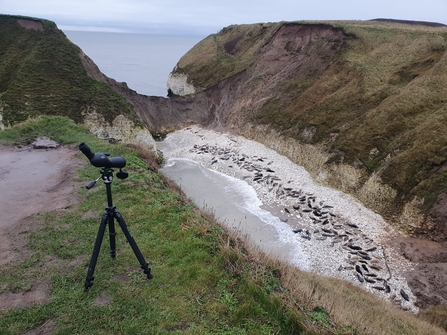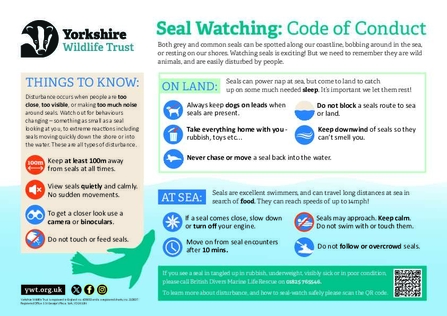Around the UK, the grey seal population is thought to be healthy. With our combined coastline estimated to be home to around 40% of the world’s total population. The number of seals using Flamborough Head as a haul out site has increased over the past few years. We should note that this does not necessarily mean that the seal population has increased locally – instead, these individuals may have moved to Flamborough from other sites around the coast.
Grey Seals along Yorkshire's Coast
Grey seals at Flamborough
Seal surveys
Intrigued by this change, our Marine Team have begun to conduct surveys. Equipped with binoculars, a scope, and clicker we record:
- Numbers – the number of seals present at the site. This includes individuals hauled out on the rocks (a surprising number once you look closely!), and those in the water.
- Location – where abouts on the shoreline the seals are located. Are they at the water’s edge or tucked in close along the cliffs?
- Species – there are two species of seal found in the UK: Atlantic grey and harbour (common) seals.
- Structure – the number of males, females, immatures, weaners, and pups.

Gathering information on the seals will allow us to better understand how many, and how, the seals are using the site. It will also allow us monitor changes in numbers and site use into the future.
So, what have we seen so far? On our first survey in August, over 500 grey seals were recorded at Flamborough. As the year has progressed, the numbers have steadily declined. This drop, however, was something that the team were expecting. Atlantic grey seals begin pupping in the Autumn here on the east coast. It is likely a portion of those seals seen in August will have since headed to rookeries to give birth to their pups.
Watching seals responsibly
Grey and common seals can be spotted at numerous sites along the Yorkshire coast.
It’s easy to become excited if, and when, you spot a seal bobbing along in the water, or hauled out on the beach. But it is important to ensure that you are responsible when watching seals and give them plenty of space.
Here are two simple things you can do to help protect our seals:
- Do not approach – very simply, if a seal is looking at you then it has been disturbed. Move further away from it and view using binoculars, a scope, or camera.
- Keep any dogs on a lead and under control – important for the seals, but also for your pets. Remember, seals are wild animals with very sharp teeth!

It's an exciting time for our seals, and for the Marine Team. We look forward to sharing more updates with you as our work progresses.

